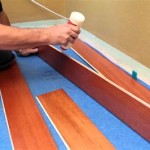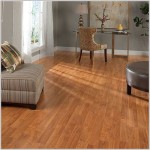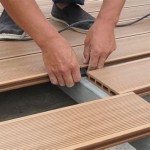How To Tell If Your Vinyl Flooring Has Asbestos
Vinyl flooring, a once-popular choice for its durability, affordability, and water resistance, can pose a significant health risk when it contains asbestos. Asbestos, a naturally occurring mineral fiber, was extensively used in building materials prior to the 1980s due to its heat resistance, strength, and insulating properties. Unfortunately, exposure to asbestos fibers can lead to serious respiratory illnesses, including asbestosis, lung cancer, and mesothelioma. Identifying whether vinyl flooring contains asbestos is crucial for safeguarding the health of individuals living or working in buildings constructed before asbestos regulations were enforced.
Determining if vinyl flooring contains asbestos is not always straightforward. While visual inspection can sometimes provide clues, the only definitive way to confirm its presence is through laboratory testing. This article will delve into the factors that increase the likelihood of asbestos content, visual indicators that might suggest its presence, and the safest methods for handling flooring suspected of containing asbestos. It will also emphasize the importance of professional asbestos testing and abatement when dealing with potentially hazardous materials.
Understanding When Asbestos Was Used in Vinyl Flooring
The historical context of asbestos use is paramount in assessing the risk within a building. Asbestos was commonly incorporated into vinyl flooring from the 1920s through the 1980s. Its presence was particularly prevalent in the backing of sheet vinyl and in vinyl floor tiles, where it served as a strengthening agent and fire retardant. Buildings constructed or renovated during this period are at a higher risk of containing asbestos-containing flooring materials.
The gradual decline in asbestos use began in the 1970s as health concerns mounted. However, existing stockpiles of asbestos-containing materials were often used until supplies were depleted. Consequently, even buildings constructed in the early 1980s could potentially contain asbestos. By the late 1980s, regulations began to greatly limit the use of asbestos. It’s important to note that the complete ban on asbestos didn't occur in many countries, including the United States. Therefore, the possibility of encountering asbestos-containing materials in older buildings should not be disregarded.
Knowing the age of the building and any renovation history is crucial. If the building was built before the 1990s, especially before the 1980s, and the flooring has not been replaced, the likelihood of asbestos being present is higher. If renovations were conducted, examining records or contacting previous owners or contractors can provide valuable information about the materials used.
Key Indicators That Might Suggest Asbestos
While visual inspection alone cannot confirm the presence of asbestos, certain characteristics can raise suspicion and warrant further investigation. These indicators involve examining the flooring's appearance, construction, and any markings that may suggest its age or composition.
One common indicator is the size of the floor tiles. Asbestos-containing floor tiles were frequently manufactured in 9x9 inch and 12x12 inch sizes. While tiles of these sizes are still produced today, their prevalence in older buildings should raise concern. Sheet vinyl flooring from the mid-20th century also frequently contained asbestos in its backing. Look for thick, paper-like or felt-like backing layers, which might encapsulate asbestos fibers. If the edges of the flooring are visible, carefully examine the layers for any sign of this backing material.
Another potential clue is the presence of adhesive residue beneath the flooring. Asbestos was sometimes added to the adhesives used to install vinyl flooring. If the flooring is damaged or being removed, examine the adhesive for a dark, tarry appearance or a fibrous texture. However, even if the adhesive appears typical, it is essential to proceed with caution as asbestos is microscopic.
Pay attention to the condition of the flooring. Old and damaged vinyl flooring is more likely to release asbestos fibers. Cracks, tears, and crumbling edges can all contribute to fiber release. If the flooring is brittle or easily broken, it may indicate age and potential asbestos content. Additionally, look for staining or discoloration, which can indicate deterioration of the flooring material. Dust or debris accumulating around damaged areas should be treated with extreme caution.
It’s crucial to reiterate that these visual indicators are merely suggestive. Modern flooring may mimic the appearance of older asbestos-containing materials. Therefore, any suspicion should be confirmed through professional testing before any disturbance occurs.
The Importance of Professional Asbestos Testing
The only way to accurately determine if vinyl flooring contains asbestos is through laboratory testing. Attempting to identify asbestos based solely on appearance or age is unreliable and can lead to inaccurate conclusions. Certified asbestos testing laboratories use specialized equipment and techniques to analyze samples and identify the presence and type of asbestos fibers.
The testing process typically involves collecting a sample of the flooring material and submitting it to a qualified laboratory. It is crucial to collect the sample properly to minimize the risk of fiber release. The recommended method is to wet the area to be sampled with water containing a small amount of detergent to help bind any loose fibers. Then, carefully cut out a small piece of the flooring using a sharp utility knife. Place the sample in a sealed, airtight container, such as a zip-lock bag, and label it clearly with the date, location, and any other relevant information.
It is strongly advised that a trained professional collect the sample. Improper sampling techniques can disturb the asbestos-containing material, releasing fibers into the air. A professional will have the necessary protective equipment, including respirators and disposable clothing, and will be trained in proper sampling procedures to minimize the risk of exposure. The cost of professional sampling and testing is a worthwhile investment in safety and peace of mind.
Once the sample is submitted to the laboratory, it will be analyzed using techniques such as polarized light microscopy (PLM) or transmission electron microscopy (TEM). These methods allow analysts to identify the type and concentration of asbestos fibers present in the sample. The laboratory will provide a written report detailing the results of the analysis. If asbestos is detected, the report will typically indicate the type of asbestos and its concentration as a percentage of the material's total weight.
It is important to choose a qualified and accredited asbestos testing laboratory. Verify that the laboratory is accredited by a recognized organization, such as the National Voluntary Laboratory Accreditation Program (NVLAP) in the United States. Accreditation ensures that the laboratory meets specific quality control standards and employs qualified personnel. A reputable laboratory will also provide clear and concise reports that are easy to understand.
Handling Vinyl Flooring Suspected of Containing Asbestos
If vinyl flooring is suspected of containing asbestos, it is essential to take appropriate precautions to minimize the risk of exposure. The primary goal is to avoid disturbing the material, which can release asbestos fibers into the air. Any activity that could damage, break, or generate dust from the flooring should be avoided until testing confirms whether or not asbestos is present.
If the flooring is in good condition and undisturbed, it typically does not pose a significant health risk. Asbestos fibers are only hazardous when they become airborne and are inhaled. Encapsulating the flooring with a sealant or covering it with another layer of flooring can help prevent fiber release. However, only undertake these actions if the existing flooring is intact and not showing signs of damage.
Never attempt to remove asbestos-containing flooring without professional assistance. Asbestos abatement is a specialized process that requires specific training, equipment, and procedures to ensure the safe removal and disposal of asbestos-containing materials. Improper removal can release large quantities of asbestos fibers into the air, creating a significant health hazard for anyone in the vicinity.
If removal is necessary, hire a licensed and qualified asbestos abatement contractor. The contractor will conduct a thorough assessment of the area, develop a detailed abatement plan, and implement appropriate safety measures, including containment barriers, air filtration systems, and personal protective equipment. They will also follow strict regulatory guidelines for the proper disposal of asbestos-containing waste.
Even minor repairs to flooring suspected of containing asbestos should be approached with caution. Avoid sanding, drilling, or cutting the material. If repairs are unavoidable, wet the area thoroughly before working on it to minimize dust generation. Wear a respirator approved for asbestos protection and dispose of any waste materials properly.
Prioritizing safety is essential when dealing with potentially asbestos-containing materials. While the presence of asbestos in vinyl flooring does not automatically create a health crisis, it warrants careful assessment and appropriate action. Professional testing and abatement are crucial for ensuring the safety of individuals in buildings constructed before asbestos regulations were enforced.

How To Identify Remove Asbestos In Linoleum Flooring Ferro

Asbestos Vinyl S History Dangers Abatement

6 Easy Ways To Identify Asbestos In Your Home Without A Specialist

Asbestos Floor Tiles What Does In Flooring Look Like

Testing For Asbestos In Black Mastic

What Does Asbestos Tile Look Like In Flooring

6 Easy Ways To Identify Asbestos In Your Home Without A Specialist

Asbestos Floor Tiles Must Know Safety Information Haztrainer Multi National Inc

Vinyl Floor Tiles And Covering Asbestos

Asbestos Vinyl S History Dangers Abatement
Related Posts








